Remnants of Britannia's past as resort getaway up for heritage protection
Residents worry it would leave them with rodents, mould, sagging foundations.


Social Sharing
The City of Ottawa wants to preserve Britannia Village's history as a summer resort, but some worry a heritage designation will leave them stuck with rickety homes close to ruin.
During a built heritage committee meeting on Tuesday, city staff initially recommended eight properties for heritage designation, most of them built as second homes for wealthy families who flocked to Britannia as a bucolic Ottawa River getaway.
Lesley Collins, the city's program manager for heritage planning, said the cottage community grew from "the Victorian ideals of taking the airs and getting out of the heat and dirt of the city in the summertime."
Britannia's "golden age" arrived with the streetcar around 1900, with most of the properties under consideration dating from that era or shortly before.
Wrapped in generous verandas, some come with rustic-sounding names like "The Pines" and "The Gables."
"It's a very unique story in Ottawa's history," said Collins. "It actually speaks to early ideas about transit and how transit can spur development."
Summers spent yachting on Ottawa River
The former inhabitants were businesspeople, civil servants and local officials from Nepean Township.
Many played a leading role in the early history of what's now the Britannia Yacht Club, whose 19th-century clubhouse was the eighth property on the designation list.

The original homeowner of 195 Bradford St., dentist Mark McElhinney, was a prominent member of the club. Malcolm Campbell now lives in that home.
He came to committee on Tuesday to ask it to hold off on the designation, at least until it can be checked by a structural engineer.
Campbell said people come by the home to "smile and remember how it was." But he said the house is chilly during winter, and sits on a foundation of timber and flagstone.
In his view, its original inhabitants could never have expected it to last 126 years.
"The stone is sagging, the wood is deteriorating and I'm getting dry rot. It's heartbreaking," Campbell said.
"I've painted it and loved it and done the basic sweat equity to the home, however I do believe it is approaching the finish line of its lifespan."

Staff ultimately recommended deferring that designation to allow more time to consult with Campbell, who was out of the country as they worked with other residents. That left seven properties on the list.
The committee voted to designate all seven, sending them to council for final approval.
Bay Coun. Theresa Kavanagh called Britannia Village "a real jewel" in her ward, which doesn't usually see many heritage designations.
'It reminds them of the old times'
Heritage designation can mean complications for residents who want to renovate their properties, since alterations and additions require city approval.
Significant work or demolition requires council to weigh in through a process that can be time-consuming and expensive.
But designation also opens the door to grants that can help residents keep heritage properties in good repair.
- City rushes to grant heritage status to 'most critical' buildings
While Campbell got a reprieve, Janet Durno didn't. She lives just down the street in a 120-year old cottage once inhabited by civil servant and yacht club member Ebenezer Stockton.
Now she's dealing with wet and mouldy insulation, an unusable fireplace and an unfortunate groundhog that died while shorting out her electrical system.

"I do value the heritage nature of Britannia, and for many years have maintained my old house at considerable cost, but I am very concerned about the proposal to designate it," she said.
"In my view the house is becoming increasingly fragile. It was built as a cottage with little storage space, no basement or proper foundation."
Collins called the reality in Britannia Village an "unusual situation," but noted that there are several heritage homes in Lowertown without modern foundations.

Campbell said he's studied the "wonderful history" of Britannia Village and respects the need to commemorate it, but he thinks some properties might be beyond saving.
"I can understand the city and people loving it because it reminds them of the old times and what it used to be like," he said. "Yet you are sort of stuck with that small cottage as your principal residence, so it's a little tricky."
ABOUT THE AUTHOR

Arthur White-Crummey is a reporter at CBC Ottawa. He has previously worked as a reporter in Saskatchewan covering the courts, city hall and the provincial legislature. You can reach him at [email protected].
Related Stories
- Ontario passes housing bill amid criticism from cities, conservation authorities
- Building owner pushing back on new heritage protection
- Heritage status for problem-plagued church could cost millions, pastor says
Britannia Yacht Club
By byc 125 anniversary committee.
Summer 2018
A History of Water, Place and People.
- Jane Doe, Tennis Pro
I n 1887, the Britannia Aquatic Club was established as an informal organization by summer residents interested in boating and other water activities. One of Ottawa’s many sawmills, built by J.C. Jamieson where Lac Duchenes meets the Ottawa River, became the meeting place. This was the start of the club which in now known as the Britannia Yacht Club. The first clubhouse was completed in 1896, which included storage for boats and a second floor “fixed for purposes of social enjoyment.” The present club house is an enlargement of this first building.
As any Club with as extensive history as Britannia, it is so much more than just a building, harbour and place to park a boat. Our history includes fires and storms; many thousands of hours of volunteer work and labour; world champion sailors and a world famous innovative boat design – the Laser. As well as tennis.
Even though the Club's charters have always contained the requirement to promote and encourage land activities, only tennis has retained a full, active partnership with the Club's aquatic sports, but just as there have been ebbs and flows in the boating world so periods of tennis activity have been marked by doldrums and vibrant, exciting times. What appears to remain constant for our tennis players through ninety two years of Club activity is dedication to the sport, deep affection for the Club, and fellowship.
It is hard to imagine the Club without its tennis courts delighting the eye between parking lot and clubhouse. An interesting story was uncovered while reseraching our 125th Anniversary Book.. Apparently the tennis players can thank Mrs. Eileen Kirby for the tennis courts. She reportedly did not enjoy sailing in the least, and desperately longed to play tennis – her favourite sport. In 1926 husband David, with the help of others, built a tennis court on the east side of the then clubhouse – thus starting tennis in the Britannia Boating Club with two more courts were added in 1927. These were clay courts and in the 30’s were a hive of activity - except when it rained and they had to dry out.
Don McDairmid
One family they attracted was the McDairmids. Eleanor and Mac were playing in the early thirties. Along came Don in 1934 and younger sister Flo and brother Cliff joined in 1937. They had extraordinary talent and enthusiasm and their names are emblazoned on the Club's tennis trophies. They teamed up with other Club hotshots. Mac and Al Jacques formed a superb team, but it was Don who possessed the winning combination of heart, skill and dedication. The Rideau Tennis Club spotted his potential, paid his fees, bought his equipment and coached him. Their investment paid handsomely. Don dominated the Ottawa Open for years. He won the Quebec Open and Eastern Canada Open, and in 1940 topped it all off by becoming Canada's no. 1 Male Singles tennis player by winning the Canadian Open Tennis Tournament. He returned to tennis after serving in World War II, and in 1946 played for Canada in the Davis Cup, winning all of his matches. In 1978, the Sports Hall of Fame recognized his achievements. Perhaps the most noteworthy achievement of all is that he, like his friend Al Jacques, did not let the fact that he was well past three score and ten stop him from playing a good game of tennis and contributing priceless stories to this history. As recently as 1993, Don and partner were runners-up in the 75+ men's doubles in a national event.
Playing on the clay courts, circa 1940.
The calibre of play during this period was extremely high and the tennis players were described as a "close knit bunch". Lorne Smith was a star player and he turned down a coaching offer from the Rideau Club to stay at Britannia and continue with his career. Sixty-five years later he and his wife, Gladys, were still members of BYC. There was keen competition between tennis clubs in the thirties, a fact made all the more remarkable because most of the players travelled by street car to get to their games. Britannia had no lights on the courts and tennis players did much of the court maintenance. There was no club manager in those days - the Board ran everything. As Tennis Director, Lorne tried hard to get a shower installed. Don Kirby, forever a sailor, said "If you need a bath after tennis, do what we do - jump in the river." Eventually the first showers were installed by Tom Fuller - that consummate sailor!
When war was declared in 1939, Canada's finest, including many of the Club's young athletes, joined up and left for overseas. There were no Canadian championships between 1940 and 1945, and play at the Club was in the doldrums as the nation concentrated on the war in Europe. Spring of ‘45 brought hope for a new world and on July 7, 1945, the first post-war Canadian Open Tennis Tournament was scheduled. Due largely to extensive court renovations organized by Len Ball, 1946 was described as "one of the best seasons in the history of the Club." Lighting was improved and two well-lit courts permitted play until 11 p.m. and extended the season to October 15th.
The early 50s were good years for tennis even though 1951 started off with a major catastrophe when high spring floods damaged all the courts and washed the clay off court No.1. Perhaps adversity brought out the best in players, for the early fifties seemed to bring out a generous sharing of talents. There were no hired pros, but the better players became dedicated instructors. The tennis records were full of cancellations of play and of tournaments due to weather and unplayable clay courts. Weather dictated court time.
John Brown Tennis Director in 1969 continued the battle to have all-weather courts installed. He estimated that it would save the Club $2,500 per season in court maintenance salaries. At last, in 1972, a step was taken in the right direction. An experimental all-weather court was constructed on court one with most of the work carried out by tennis players under the direction of Don Folger. The plan was to press for all court coverage if the experimental court was successful. In 1973 Len Ball was on the Club's Board in charge of House and Grounds - the right man, in the right place, at the right time. In the spring of 1975, he organized a plebiscite of all members seeking approval for the outlay of funds to install Plexipave tennis courts. The completed questionnaires revealed a majority approval. By 1984 Len Ball had organized the resurfacing of five courts with Plexipave and upgraded the night lighting.
Steve Ball, Len’s son was hired in the summer of 1980 to give free tennis lessons to members of the Junior Sailing Squadron - a first - and Tennis Director Chris Kidd recorded another first when he spotted two players enjoying a game on BYC courts on February 27, 1981! 1987 saw a new phase in club tennis when Tennis Director Josie Braden organized winter tennis sessions for BYC players - first at the Thunderbird Tennis Club and then at the West Ottawa Tennis bubble.
Len Ball, centre, surrounded by fellow club members.
The National Capital Tennis Association 55+, 45+ and 35+ veterans tournaments were played on our courts attracting the best age group players from the entire National Capital area. BYC hosted the Classic Tournament for 14-and-Under Juniors from across Canada. The Wheelchair Tennis Tournament, sponsored by NCTA in August 1990 and played at our Club put a new perspective on guts and effort. Tennis Director Calvin Smith wrote that "it was a pleasure and honour to have this group as our guests at BYC."
Sixty tennis enthusiasts attended a buffet and Spring Tennis Meeting in April 1991 and the 90s were off to a rousing start. Round Robins flourished, often followed by social gatherings. 1993 saw the beginning of "Strawberries and Wimbledon" - round robin play, finals from Wimbledon on TV, all washed down with the traditional bubbly and strawberries and cream.
The Club’s tennis players are very engaged and ensure that the courts are well maintained and provide the best playing experience possible. In 2008 the tennis players, through the allocation of their capital surcharge to the Tennis Program, had raised sufficient funds and the courts were once again resurfaced in their current plexi-pave blue surface. In 2012 Court 1 was retired in preparation for planned future alterations to the clubhouse. As a result, there are now four courts. A new fence was installed around these courts, and this is a major improvement to the appearance.
The BYC community gathered together to dedicate the tennis courts in memory of Len Ball. His longstanding dedication to the development of the sport of tennis and custodianship of the tennis courts at BYC was outstanding. Simon Fuller shared some personal memories of Mr. Ball. Len was involved in all aspects of the Club. He was an avid tennis player, sailor and a longstanding member of the BYC Board of Directors. Phil Moorman cut the ceremonial ribbon to dedicate the “Leonard Ball Courts” to close the ceremony. As part of the kickoff for the week-long 125th anniversary celebrations, BYC hosted a Junior Tennis Tournament. BYC was a hive of activity with a full draw of junior-aged players. Players and parents experienced sailing, some for the very first time. The Club history displays and the positive atmosphere of BYC in between matches helped to make this event a great success.
The history grows every year at BYC. Pickleball has been added as an additional activity on the courts. 2018 will see the courts and lights again being repaired and upgraded. Traditions continue. Wimbledon Sunday’s Strawberries and Cream is on its 26th year, and we have now added French Open Sunday Cafe au Lait & Croissants, a mere 5 years old. Tennis Planning and Programming is still done by a volunteer commitee, and we still are hosting NCTA Tournaments.
Advertisement
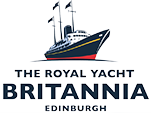
- Royal Deck Tearoom
- Group Visit
- Accessibility
- Annual Pass
- Our Green Tourism
- Weekly Snaps
- Things to do in Edinburgh
- What's On
- Private Events
- Private Dining
- Drinks Reception
- Private Tours
- Burns Supper
- Meet The Team
- Historical Timeline
Explore Britannia
- Royal Residence
- Life Below Decks
- Bestsellers
- Gift Vouchers
The Royal Yacht Britannia, Ocean Drive, Leith, Edinburgh EH6 6JJ
Tel: 0131 555 5566 Email us: [email protected]
Please pre-book your tickets to guarantee admission

- Search this website
A Floating Palace
Britannia was launched from the John Brown & Company shipyard in Clydebank, Scotland, on 16 April, 1953. For over 44 years the Royal Yacht served the Royal Family, travelling more than a million nautical miles to become one of the most famous ships in the world. To Queen Elizabeth II, Britannia provided the perfect Royal residence for glittering state visits, official receptions, Royal honeymoons a nd relaxing family holidays. For Great Britain, she was a majestic symbol of the Commonwealth and a proud ambassador generating billions of pounds in trade deals. For the Royal Family and 220 dedicated crew of Royal Yachtsmen, she was home.
Today, Britannia is a five-star visitor attraction and exclusive evening events venue in Edinburgh.
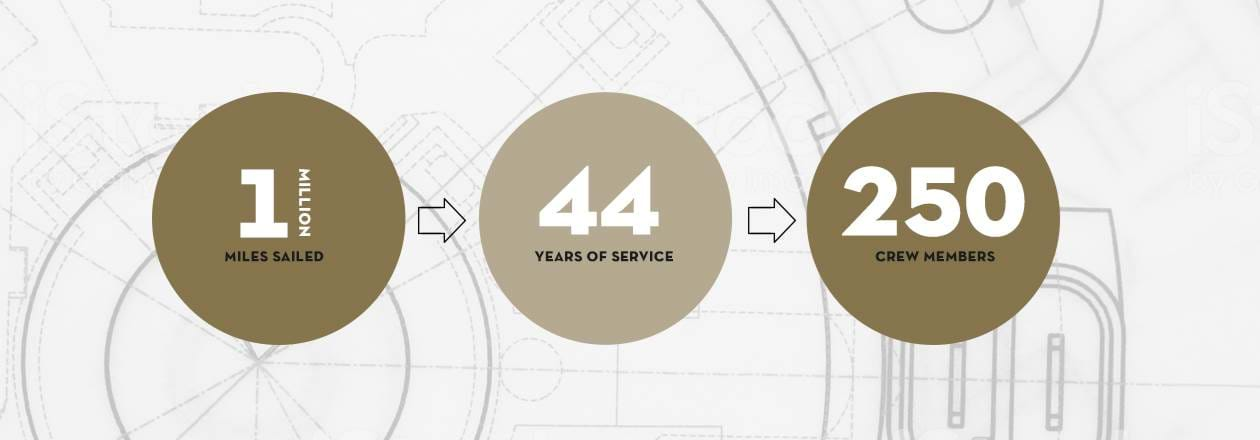
Start at the Bridge, explore the State Apartments, Crew's Quarters and finish at the Engine Room.
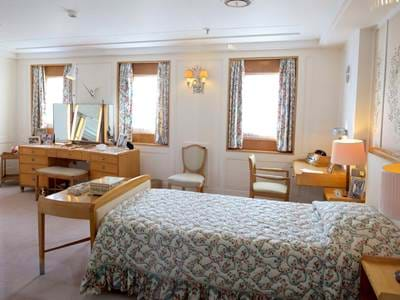
View The Royal Residence
Discover why Britannia was so special for Queen Elizabeth II and the Royal Family.
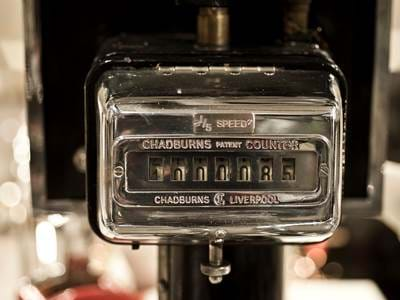
Glance Below Decks
Find out about life on the ocean wave for the crew, the Royal Yachtsmen, also know as the ‘Yotties’.
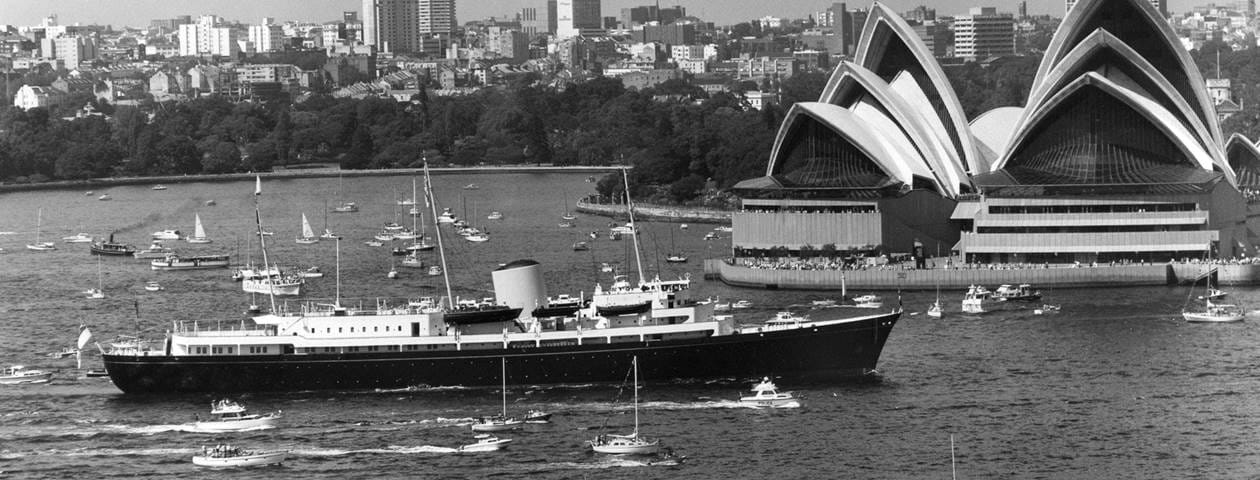
The Britannia's Timeline
Britannia holds a special place in maritime history as the last in a long line of Royal Yachts.
Visiting Britannia
TRIPADVISOR'S NO.1 UK ATTRACTION 2023 - 2024

Click on the Visit page for more information before you visit.
Step aboard to enjoy a great day out!
Fingal Hotel
Get away from the everyday aboard Britannia’s sister ship, Fingal. Extend your visit with a stay in one of Fingal’s luxurious cabins, your own oasis by the sea.
TRIPADVISOR'S NO.1 UK LUXURY HOTEL TRIPADVISOR'S NO.1 UK SMALL & BOUTIQUE HOTEL AA Hotel of the Year Scotland, AA five-star hotel and 2 AA Rosettes

Learn more: fingal.co.uk

Britannia Yacht Club
- Britannia Village History
Ottawa, Nepean, Ontario K2B 8J8, Canada
Created By: Douglas T Stiff
Information
This clubhouse was built in 1896, on property leased from Ottawa lumber baron J. R. Booth, after the Britannia Aquatic Club had outgrown John Jamieson’s converted sawmills and cottages that had been used since its foundation in 1887. The club operated from the boathouse at Britannia Pier from 1904 to 1918, relocating to this site once more after boathouse on the pier burned down.
Using volunteers from the BYC previous club Commodores, Thomas G. Fuller and Reginald G. Bruce expanded of the existing abandoned Metropolitan Power Company Canal from 1899 to create the club’s sheltered harbour.
The club has received numerous awards and distinctions throughout its 130 year existence…
This point of interest is part of the tour: Britannia Village History
Leave a Comment
Download the app, download the pocketsights tour guide mobile app to take this self-guided tour on your gps-enabled mobile device..

Updates and Corrections
Please send change requests to [email protected].
The Britannia Association
- His Majesty King Charles lll
News & Events
- Media & Downloads
- Aims & Objectives
- Eligibility
- Membership Opportunities
- History Timeline
- Fund Raising
- Membership Types
- Find a Member
- Classifieds
- Latest News
- Upcoming Events
- Browse Shop
Britannia Yacht Club is Relaunched
- Author: BRNC
- Date: Wednesday 17th October 2018
Former members of the Britannia Yacht Club (BYC) are being asked to get in touch as the club approaches its 60 th anniversary.
The club, which was originally founded in 1959, has been re-launched at Britannia Royal Naval College (BRNC) with Captain Jol Woodard, the current Commanding Officer of BRNC, taking on the role of Commodore of the club.
Captain Woodard said: “Sailing is an ideal way for naval personnel to understand the environment that we operate and fight in, particularly for our cadets and young officers under training. It allows them to put into practice the theory they are taught in the classroom and learn from more experienced members of the club, including our Staff Officers, and to have fun. We would like people who were members of the club to get in touch with us and renew their affiliation.”
The fleet of five Contessa Yachts based at the college and sailed by the BYC allow for training, skill development and team racing. This year they have been competing with the Royal Dart Yacht Club in their Spring series on Wednesday evenings as well as a number of regattas along the South coast, Dartmouth Royal Regatta and Cowes Week.
Midshipman Connor Brain, Club Captain, said: “It is great to see the BYC up and running and we hope to work together with all members to revive the heritage of this prestigious club.”
In the past the club was very active both afloat and socially. Guests of honour at club dinners included the Rt. Hon. Sir Edward Heath (Jul 1994), Pete Goss MBE (Jul 1998), Sir Robin Knox Johnson (Jun 2002).
The BYC Committee is keen to renew the annual dinners which were so popular in the past and have agreed to host the next dinner on Thursday 20 June 2019. Details will be announced nearer the time.
To get in touch former members should write or email the Secretary, BYC, BRNC, Dartmouth [email protected]
Return to listings
Member Login
Membership application.
Want to apply for membership? Want to become a part of our vibrant alumni?
Click below to begin the application process.
Royal Patronage
The Association is formally recognised as a charity whose Royal Patron is His Royal Highness Admiral of the Fleet Prince of Wales (KG KT GCB OM AK CD QSO PC)
The Association is a registered charity. Our Royal Patron is His Majesty King Charles III
- Opportunities
Office Details
Britannia Association Office Britannia Royal Naval College College Way, Dartmouth, Devon TQ6 0HJ
[email protected] Tel: 01803 677565 Mil: 93 749 7565
- Follow us on
© The Britannia Association 2024 - All Rights Reserved Registered Charity No. 1158111 - CIO No. 9119745 Email: [email protected] | Tel: 01803 677565 | Privacy Policy | Refund Policy

The Story Behind the Royal Family's Yacht, Britannia
The ship hosted four royal honeymoons in its 44 years of service.

Often referred to as the last royal yacht, the Britannia was decommissioned in 1997, and despite some efforts , there are no signs of a new one in the near future. Though its seafaring days may be behind it (the ship now serves as a tourist attraction in Edinburgh, Scotland), the Britannia remains an important artifact and a peek behind the curtain of royal life—it even garnered a prominent place in the fifth season of The Crown . Below, a few of its most notable moments throughout history.
It was the first royal yacht designed for ocean travel.
The ship was built by John Brown & Co at the same shipyard in Clydebank, Scotland in the same location the famous ocean liners the Queen Elizabeth and Queen Mary were constructed. With 12,000 horsepower, the ship could travel at a maximum 22.5 knots (approximately 25 miles per hour), ideal for ocean-going diplomacy. Prior to its launch in 1953, the royal family used ships from the Royal Navy or even passenger liners for the overseas portions of the royal tour.
In its 44 years of service, the HMY Britannia traveled around 1.1 million miles.

It was commissioned just two days before the death of King George VI.
The King was already in failing health by the time the designs for the HMY Britannia were submitted, and the hope was that traveling might help alleviate some of his symptoms. However, just two days after the John Brown shipyard in Clydebank, Scotland received the order the King passed away on February 6, 1952.
It would take just over a year for the ship to be completed, during which time its name remained a secret—it wasn't announced until the ship's official launch in April of 1953, less than two months before the Queen's coronation . Elizabeth cracked a bottle of English wine (in the post-war era, champagne was considered too extravagant for the launch of a ship) and announced, "I name this ship Britannia … I wish success to her and all who sail in her."
It was created to double as a hospital.
When Britannia was first envisioned, less than a decade after the end of World War II, the designers sought to make it as functional as possible, crafting a space that could be converted from an ocean-going royal residence to a seafaring hospital during any possible future wartime. The main veranda was laid out and re-enforced so that it could support a helicopter landing and the laundry was made much larger than on a standard naval vessel to accommodate the potential patients. Though the ship was never actually put to that purpose, it was pressed into service on a rescue mission to help evacuate European nationals from South Yemen in 1986.
The ship was home to a lot of history.
Long before it became a floating museum, the Britannia had an eye for history. The gold and white binnacle housed on the ship's veranda deck was originally part of the HMY Royal George , a royal yacht that served Queen Victoria . Likewise, some of the bed linens used by Queen Elizabeth aboard the vessel were originally made for Victoria's bed for one of the previous royal yachts.
Britannia's steering wheel was lifted from her namesake, the racing yacht HMY Britannia , built in 1893 for King Edward VII .
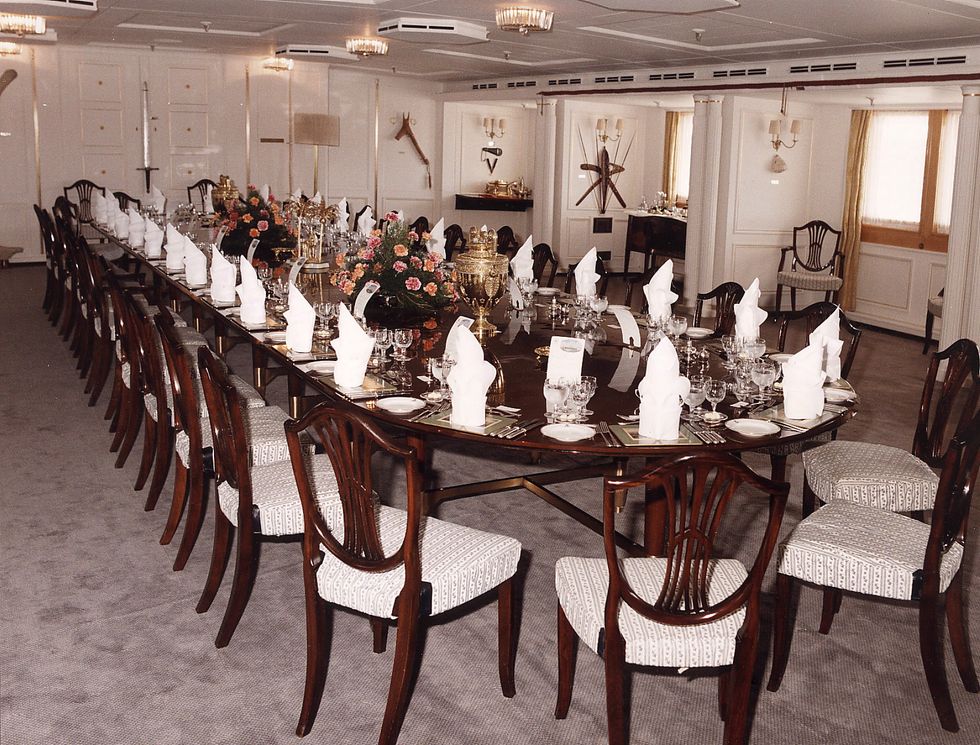
It was redesigned to be less opulent.
Despite the sense of luxury that the term "royal yacht" inspires, the Queen and Prince Philip were actually concerned when they began overseeing the project in 1952 that the original interior design plans by the design firm McInnes Gardner & Partners were too lavish for a country still recovering from the war. The interiors were ultimately redesigned by Sir Hugh Casson and received very minimal updates throughout her 44 years of service.
But it still had homey touches—by royal standards.
Suffice to say that even low-key royal living is a fairly high class. In addition to the 56-seat State Dining Room, which hosted luminaries including Winston Churchill, Noel Coward, Nelson Mandela, and multiple US Presidents, the ship also sported a formal staircase where the Queen would greet guests, separate bedrooms and sitting rooms for both Her Majesty and the Duke of Edinburgh, and a phone system designed to match the unique configurations of Buckingham Palace's telephones.

In the early years of the Britannia's life it was also home to the Queen's Rolls-Royce Phantom V which was hoisted and lowered from a special garage compartment at port so that the Queen could drive her own car at each location. The space was ever so slightly too small, forcing the bumpers to be removed in order to get it into the garage without damage and then refitted when the car was removed. Ultimately Elizabeth began using cars provided for her at port instead and the garage was converted into a storage area for beer.
The steering crew couldn't see where they were going.
Life on board the HMY Britannia was far from typical for her crew. To begin with, due to the prestige and pressure of the position, the commanding officer of the royal yacht was always a flag officer, most commonly a Rear Admiral, although the first two to serve were Vice Admirals, and Britannia 's final CO was a Commodore.
While working, the crew reportedly used hand signals to communicate rather than shouting orders, in order to maintain a sense of quiet and calm for the royal residents. It was also the last ship in the royal navy where the crew members slept in hammocks, a practice that they maintained until 1973.
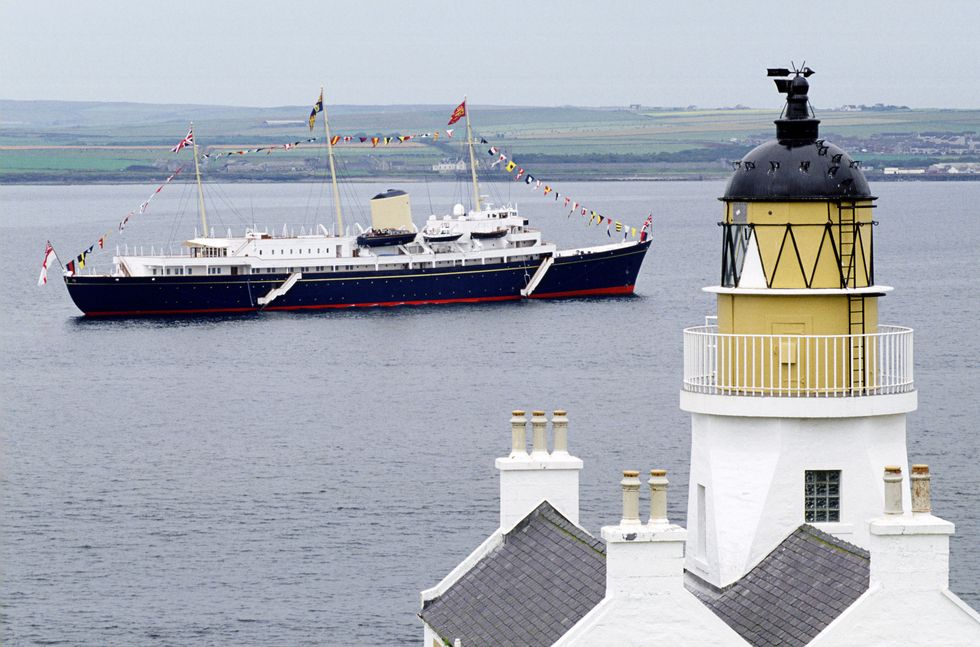
Perhaps the most unusual element of the ship's functioning, though, was the steering. While on most ships, the steering wheel sits on the bridge, overlooking the front of the vessel, Britannia 's was on the deck below, in the wheelhouse, which meant that the yachtsmen who were actually doing the steering couldn't see where they were going. The crew got around this rather surprising pitfall by using voice pipes from the bridge to confer navigational orders.
It was a royal honeymoon essential.
No fewer than four royal couples celebrated their honeymoons in the HMY Britannia 's honeymoon suite (the only room onboard with a double bed.)
Princess Margaret started the tradition in 1960 for her Caribbean honeymoon with Anthony Armstrong-Jones , a quiet, formal affair where dinners were taken in full evening dress every night. Things didn't go quite as smoothly for Princess Anne on her honeymoon with Captain Mark Phillips in 1973—storms and 20-foot waves left the couple stricken with seasickness for the first week of their Caribbean cruise. Prince Charles and Princess Diana famously spent their 1981 honeymoon on a Mediterranean cruise aboard the yacht. The crew managed to duck the press so efficiently they garnered the nickname "the ghost ship." The final royal honeymoon aboard the Britannia was taken by Prince Andrew and Sarah Ferguson , Duchess of York in 1986 when the couple traveled around the Azores.
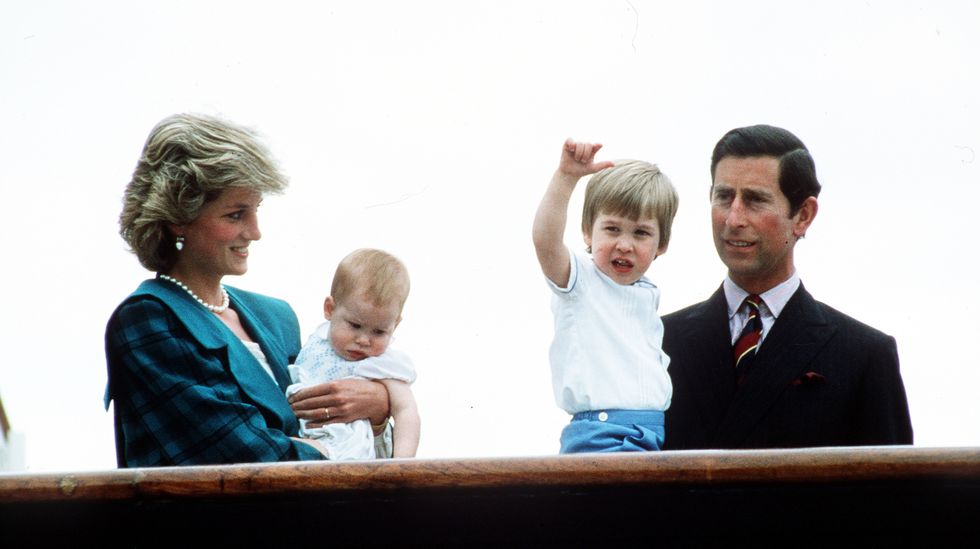
And a family vacation spot.
In addition to her diplomatic duties on royal tours and her service as a post-wedding retreat, the Britannia was also a vessel for family vacations. During the summer months, the royal family would often take off on what became known as the Western Isles tour, cruising around the western isles of Scotland. During the trip, the family would play games and have barbecues on the islands. The stairway off of the veranda was sometimes even converted into a waterslide for the younger royals. The tour often included a stop off at the Castle of Mey to visit the Queen Mother, then making berth in Aberdeen so that the Queen could travel to her favorite summer home, Balmoral .
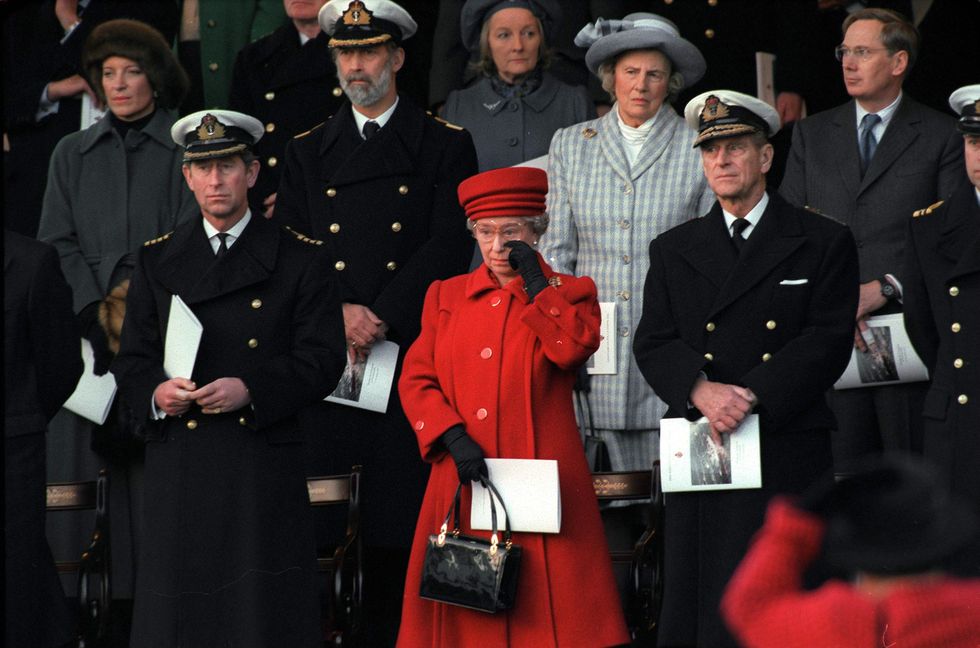
The Queen openly wept when HMY Britannia was decommissioned in 1997.
With so many memories around the yacht, it's not hard to understand why the decommissioning of the Britannia was upsetting for the royal family. Though plans were initially drawn up for a replacement yacht, the government ultimately determined not to fund the effort. After the Queen officially took her leave of it in 1997, the ship was placed in the port of Leith in Scotland where it serves as a floating museum and events venue . All of the clocks on board remain stopped at 3:01, the exact time that Her Majesty disembarked for the last time.
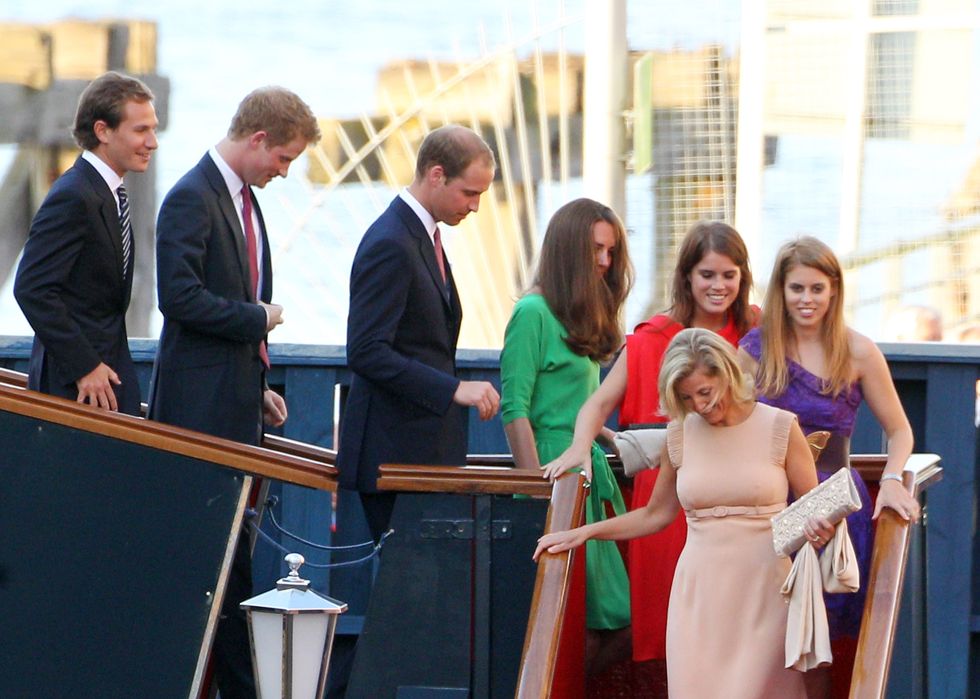
It was used for a reception for Zara Phillips before her wedding.
Though it's no longer used as their private vessel, the Britannia 's connection to the royal family didn't end in 1997. In 2011 on the night before her wedding, the Queen's oldest granddaughter Zara Phillips contracted the ship for a reception. Though her grandmother wasn't in attendance Zara celebrated her upcoming marriage to Mike Tindall onboard along with her mother and her cousins Prince Harry, Prince William and Kate, Princess Eugenie, and Princess Beatrice.

Lauren Hubbard is a freelance writer and Town & Country contributor who covers beauty, shopping, entertainment, travel, home decor, wine, and cocktails.
@media(min-width: 40.625rem){.css-1jdielu:before{margin:0.625rem 0.625rem 0;width:3.5rem;-webkit-filter:invert(17%) sepia(72%) saturate(710%) hue-rotate(181deg) brightness(97%) contrast(97%);filter:invert(17%) sepia(72%) saturate(710%) hue-rotate(181deg) brightness(97%) contrast(97%);height:1.5rem;content:'';display:inline-block;-webkit-transform:scale(-1, 1);-moz-transform:scale(-1, 1);-ms-transform:scale(-1, 1);transform:scale(-1, 1);background-repeat:no-repeat;}.loaded .css-1jdielu:before{background-image:url(/_assets/design-tokens/townandcountrymag/static/images/diamond-header-design-element.80fb60e.svg);}}@media(min-width: 64rem){.css-1jdielu:before{margin:0 0.625rem 0.25rem;}} Royal Family News @media(min-width: 40.625rem){.css-128xfoy:before{margin:0.625rem 0.625rem 0;width:3.5rem;-webkit-filter:invert(17%) sepia(72%) saturate(710%) hue-rotate(181deg) brightness(97%) contrast(97%);filter:invert(17%) sepia(72%) saturate(710%) hue-rotate(181deg) brightness(97%) contrast(97%);height:1.5rem;content:'';display:inline-block;background-repeat:no-repeat;}.loaded .css-128xfoy:before{background-image:url(/_assets/design-tokens/townandcountrymag/static/images/diamond-header-design-element.80fb60e.svg);}}@media(min-width: 64rem){.css-128xfoy:before{margin:0 0.625rem 0.25rem;}}

Queen Camilla's Life in Photos

Queen Camilla Wears the Diamond Diadem

Charles & Camilla at State Opening of Parliament

16 Royal-Favorite Brands You Can Shop on Amazon

Meet Peter Phillips's New Girlfriend Harriet

These Meghan Markle-Worn Sunglasses Are Essential
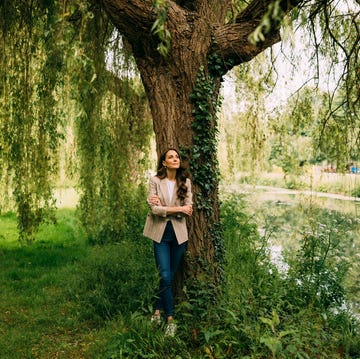
The Most Memorable Royal Photos of 2024 (So Far)

The Royal Family's Favorite Sunglasses

Timeline of Kate's Cancer Diagnosis and Treatment

Kate Middleton's Greatest Style Moments

All the Best Royal Outfits at Wimbledon
Category : Britannia Yacht Club
| Instance of | |||||
|---|---|---|---|---|---|
| Location | |||||
| Headquarters location | |||||
| Founded by | |||||
| Inception | |||||
Pages in category "Britannia Yacht Club"This category contains only the following page.
Media in category "Britannia Yacht Club"The following 158 files are in this category, out of 158 total. 
Navigation menu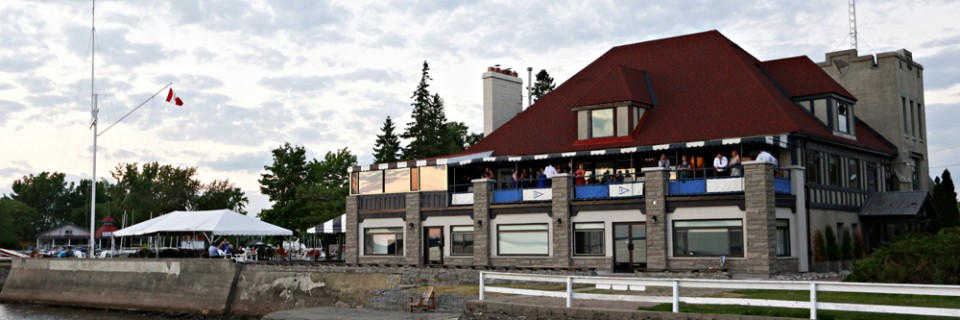 Britannia Yacht ClubYour Cottage in the City
The Britannia Yacht Club (BYC) is a private social club, yacht club and tennis club based in Britannia Ottawa, Ontario. It was founded in 1887 by a group of cottagers. [ citation needed ] The members have contributed to the sports of yachting and tennis. The non profit corporation celebrated its 125th anniversary in 2012. The main entrance is on Cassels at Bradford Street. BYC is located on an extension of land at the eastern end of Lac Deschênes near the Deschênes Rapids on the Ottawa River. A land block owned by the National Capital Commission on the south side of the harbour is leased to the BYC. The area immediately south of the property is occupied by residences of Britannia Bay. To the south and east of the property, the land is owned by the City of Ottawa and is occupied by the Britannia Water Treatment Plant, and the Britannia Conservation area. To the north, is the Town of Aylmer, Quebec across the 800 m span of the Deschênes rapids. The harbour was built from an abandoned power canal, which lay beside the club property. This harbour has been expanded twice since its original development. The harbour water level is controlled by a system of stop logs at its entrance. The harbour is a well-protected basin consisting of a main harbour and an inner harbour, which provide 250 wet moorings of the Mediterranean type or floating finger docks. There are unlimited dry mooring spaces for ramp-launched boats and for crane-launched keel boats of less than 1,360 kg.
Member Club News
 Ontario Sailing NewsletterSignup Today! Using LOCCA Website Tips
Paid member clubs can login here to manage listing details BRITANNIA RULES THE WAVES AND AMERICA WAIVES THE RULESThe Lipton era of competing for the America’s Cup drew to a close upon his passing on the 2nd October 1931 after a summer of speculation that a sixth challenge would be forthcoming under the flag of the Royal Yacht Squadron to which he had finally been elected a member, earlier in the year. With the Great Depression biting across the globe, thoughts of building large, technically advanced yachts for the upper-class pursuit of yachting were not high in the minds of owners on both sides of the Atlantic. As austere times ensued, the call for smaller racing yachts was being heard by the New York Yacht Club who initiated an international competition for the growing 12-Metre class that it was thought could well all but kill off the J-Class with its huge demands on money and resources – particularly in light of the recent money-no-object campaigns of the likes of Vanderbilt and Lipton. But over in England, a significant passing of the patriarchal baton was well underway with the emergence on the yachting scene of Thomas Octave Murdoch Sopwith, an aviation entrepreneur who had been bankrupted by punitive anti-profiteering taxes post the First World War but had re-entered the business as Chairman of Hawker Aviation in 1920 and went on to create some of the most iconic and commercially successful planes in the world. Sopwith’s eye for innovation and a determination to apply the learnings of his aviation business into the science of America’s Cup race boats led to a swift purchase of Shamrock V from the estate of Sir Thomas Lipton and the retention of Charles Nicholson as principal designer for a new J-Class commission. Furthermore, Sopwith secured the talents of Frank J. Murdoch, one of England’s finest engineers who was subsequently described as a “genius and a gentleman” in the Herreshoff Marine Museum archives, to raise the technological approach of what would become England’s finest challenger for the America’s Cup. 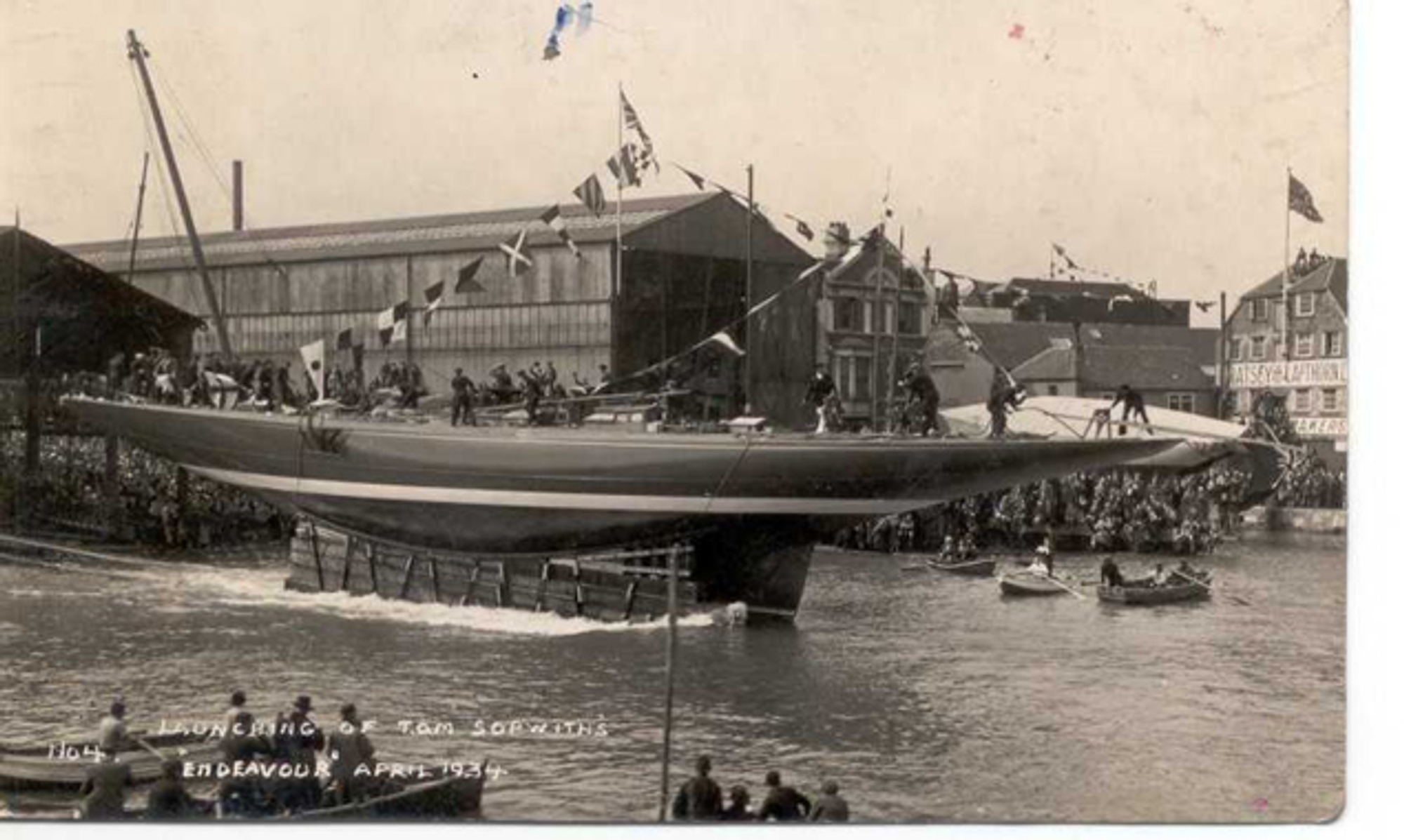 The commissioning and build process for the Endeavour programme begin in earnest at the Camper & Nicholson boatyard in Gosport in 1933 when the formal challenge was issued by the Royal Yacht Squadron in Cowes on behalf of Thomas Sopwith (he wasn’t Knighted until much later in 1953) to the New York Yacht Club. Harold Vanderbilt, aware of moves afoot in England, in particular the follow-on design from Shamrock V from the design board of Charles Nicholson in the yacht ‘Velsheda,’ had already commissioned Starling Burgess to work up plans should the inevitable challenge arrive. When it did, the Americans were at full tilt after a lengthy tank-testing programme at Ann Arbor in Michigan that produced the lines for Rainbow – a full two feet longer on the waterline and six feet longer overall than the prior defender, Enterprise. New class rules had come into effect in the J-Class which eliminated below-deck winches and demanded certain standards of accommodation but alongside the commissioning of the new Rainbow, the Morgan family’s yacht Weetamoe and the heavily modified Yankee, that was shortened and slimmed around the mid-point in a remarkable Herreshoff transformation quite unheard of at the time, were to contest the slot for the defence of the America’s Cup and secure the nomination of the New York Yacht Club. Of note and relevance for that summer of trials was the inclusion of women in significant roles on both the Yankee and indeed the Endeavour. Elizabeth ‘Sis’ Hovey, daughter of Chandler Hover, the manager of Yankee, was appointed as an active member of the afterguard throughout the trials, whilst Mrs Phyllis Brodie Sopwith, Thomas’s second wife whom he married in 1932 after the death of his first wife Beatrice in 1930, assumed the significant role as official timekeeper in the afterguard of Endeavour throughout the summer of 1934. It was certainly not the first time that women had been involved in Cup racing, with Mrs Susan Henn, wife of skipper Lieutenant William Henn, sailing aboard the Galatea to its defeat in 1886 and Lord Dunraven’s daughter, the Honourable Enid Wyndham-Quinn sailing aboard the Valkyrie II in the 1893 Cup defeat. 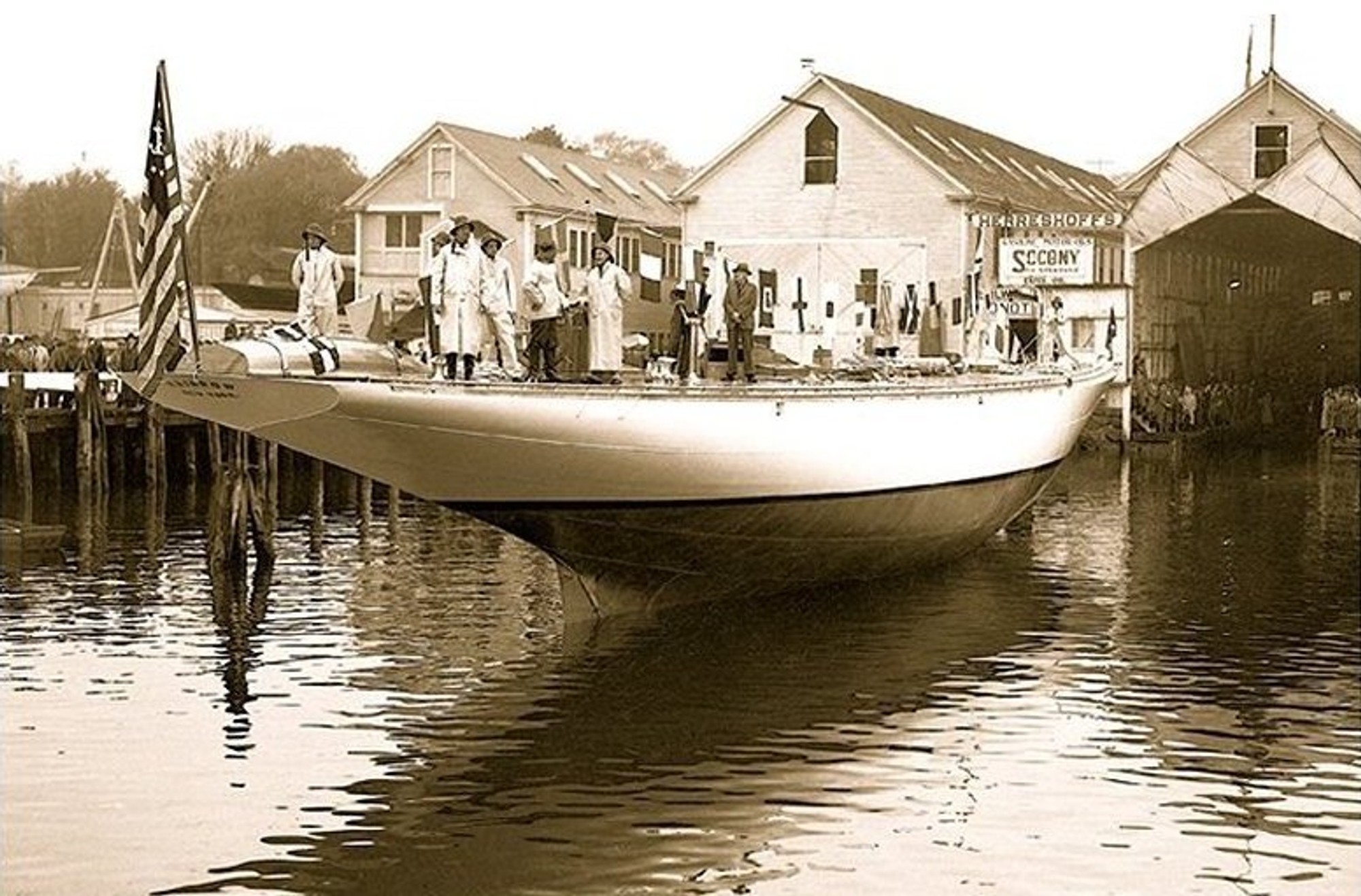 Rainbow was launched at the Herreshoff Yard in Bristol, Rhode Island a month after Endeavour in May 1934. The English yacht had slipped into the water at Gosport after the customary bottle of champagne was cracked by Phyllis Sopwith over her bows on April 16th, 1934, and was immediately commissioned, with a professional crew, on trial runs in the Solent. Endeavour was a feat of engineering that fused the nautical with the aeronautical sporting wind speed and direction instruments in the cockpit, an aerofoil shaped Duralumin mast, rod rigging (fitted later) and a novel bendy boom that had been nicknamed the ‘North Circular’ after the crescent road that runs across the top of London. It was an inauspicious start though with the boom snapping on a light air test-sail in the Solent, but Nicholson was quick to replace the boom with higher tensile stringers and the boat was sent to Harwich on the East Coast to face down the fastest boats of the British fleet. Over in America however, things weren’t going smoothly. A change in the J-Class rules had gone against the Rainbow and Weetamoe in that their centreboards were found to be some 1200 pounds more than was permitted causing some dramatic, and rather panicked, last-minute alterations. Meanwhile Yankee, whose designer Frank C. Paine, has conformed to the new rules in the extensive refit at Herreshoff’s yard was more than ready to start the defender trials that spring. Both Rainbow and Weetamoe made the appointed day of the trials, but the Morgan family yacht was quickly eliminated in a quick-fire round of match-races, apparently being no match for either Yankee or Rainbow with the latter suffering its own dose of the slows in the early matchups. But Vanderbilt had form in working-up boats over the course of a season and with a crew comprised of many that had sailed with him on Enterprise, they had experience combined with a bottomless budget and the ensuing races against Yankee were thrillers. If a campaign mistake could be attributed in hindsight to the Royal Yacht Squadron challenge of 1934, the unveiling of a quadrilateral working headsail in early trials in Weymouth Bay, was one that was deeply-rooted in the character of Thomas Sopwith. The genesis of this innovative piece of sailmaking that featured a double clew on the luff, thus creating in effect four sides to the sail, is still in doubt to this day but it was John Nicholson, the son of designer Charles Nicholson, that is widely credited with the Endeavour design that was built at Ratsey’s in Cowes. Upon receipt of the sail and whilst engaged in a tight race with Velsheda out in Weymouth Bay, Sopwith couldn’t resist the call for the sail much to the chagrin of Charles Nicholson who had firmly suggested that the sail should be trialled far out to sea in the English Channel to avoid prying eyes. In a matter of days, the design was in Newport, and it was a short time before both Rainbow and Yankee sported the sails that produced so much extra power that enhanced turning blocks were required to be retrofitted to the yachts. So sensational were the quadrilateral working-jibs that both Yankee and Rainbow sported them in a desperately close five-trial series in the summer of 1934. Vanderbilt’s well-drilled team once again extracted the maximum from their vessel, improving with each race after a loss in the opening flight by over six minutes. Yankee was a well optimised J-Class for the lighter airs, so Vanderbilt ultimately got competitive in the pre-starts knowing that his crew were the better drilled and sailed in a way to try and force errors. In the afterguard of Rainbow, Vanderbilt eventually found the combinations that worked. Tensions were high at times between Starling Burgess and Vanderbilt who fell out briefly with the skipper bringing in Zenas Bliss as navigator at the behest of sail-manager Sherman Hoyt whilst Jack Parkinson replaced Bubbles Havemeyer as the secondary helmsman downwind. Burgess and Vanderbilt made-up and the former remained in change of rigging through the match – Bliss however remained as navigator and was to prove something of a master. Despite the trial racing being tight and hotly contested, the tale of the series saw Rainbow win four of the five races – the last by just one second – and the New York Yacht Club appointed Vanderbilt’s team to the task of defending the America’s Cup. Over in England, Endeavour was putting all-comers to the sword in a series of races in Harwich and a further final trial series in and around the Solent and out further west to Torbay. Velsheda was the closest competitor, winning some notable battles in a variety of conditions, but ultimately Captain Fred Mountfield, skipper of Velsheda, came up short and Endeavour, with a record of eight wins from 12 races, was confirmed as the Challenger for the Royal Yacht Squadron. However, things were about to turn for the worse at the conclusion of the trials on the 14th July 1934 when the professional crew of Endeavour presented Sopwith an ultimatum that they would not undertake the Atlantic crossing nor the Cup series in September 1934 unless they were paid substantially more money. The employment system at the time meant that sailors were only paid until the end of the summer sailing season after which the crew would return to their hometowns to seek work on fishing boats for the winter months. With the Cup so late, they would miss the opportunity to secure slots on the fishing boats and therefore sought compensation for their loss of earnings. This garnered little sympathy with Sopwith and in return he outlined an improved offer that fell short and resulted in 15 crew hands leaving the ship, all bar two, although all of the ‘officers’ accepted the conditions. In their place, Sopwith recruited willing amateurs from the Royal Corinthian Yacht Club on the East Coast. 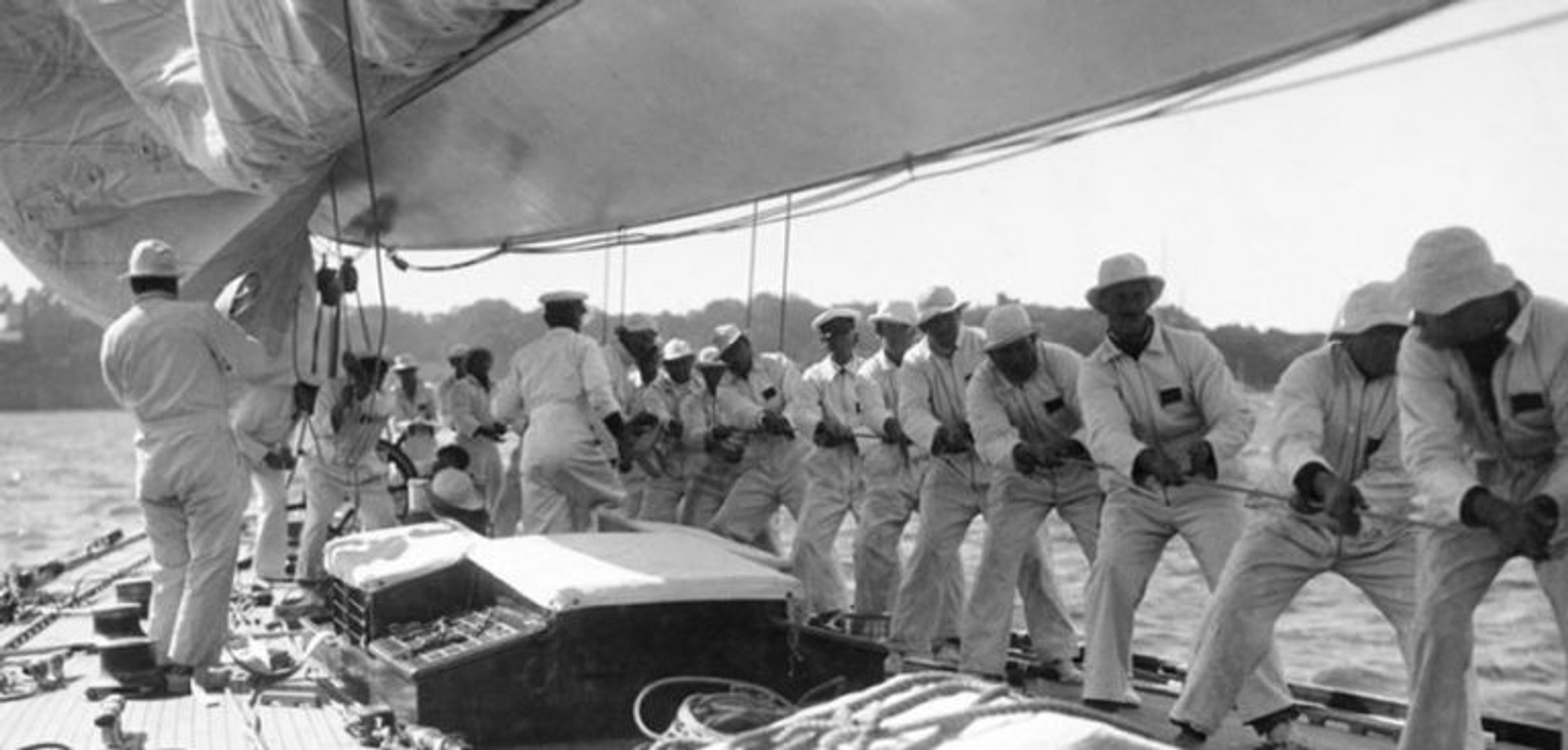 With a new crew in place, Endeavour left Gosport on 23rd July 1934 escorted for the trans-Atlantic run by Sopwith’s motor-yacht Vita. Crowds lined the shoreline as it was felt that such a technical marvel had every chance, finally, of wresting the America’s Cup from the clutches of the Americans. On arrival in Bristol, Rhode Island, her huge metal, aerofoil in shape, mast was stepped at the Herreshoff yard and for the first time, the rod rigging that had been developed by Frank Murdoch at the Hawker Aircraft facility, were applied to the rig. When the two boats were lined up for inspection however, a row emerged over the interpretation of the J-Class rules regarding fixtures and fittings below deck. Rainbow was largely a stripped-out racer whilst Endeavour still featured extensive detailing and even a bath in the state-cabin for Thomas Sopwith. The English insisted on being allowed to remove the luxuries and after much debate in yachting circles, the request was finally acceded. One other contentious issue was Rainbow’s below deck winch, outlawed in the new rules, that was operated by a coffee-grinder above. Vanderbilt argued, successfully, that due to it being operated on deck it didn’t contravene the rule and the races for the America’s Cup began on 15th September regardless. With President Franklin D. Roosevelt watching, the opening race of the 1934 America’s Cup was a thriller. A tight first leg to windward saw Rainbow round the top mark some 18 seconds up on the Challenger but a crucial error was called by the Americans who elected to launch a small parachute spinnaker whilst Endeavour set a much larger kite replete with a vertical line of holes down the centreline that aided air circulation and maintained stability. With the wind up at 15 knots, it was a big call from the English but within three miles they seized the lead and relentlessly pulled ahead. Vanderbilt took Rainbow on a circuitous course, trying desperately not to run before the wind but as the two boats came back on course deep into the run to the finish, it was Sopwith that was able to gybe for the line on a shorter course and recorded a two minute and nine second victory. With the score at 1-0, the Americans grew worried by the threat that the English were posing, particularly in the stronger breeze and race two saw no respite with a solid 14 knots recorded at the America’s Cup buoy, the starting mark some nine miles SSE of the Brenton Reef Lightship. An uncharacteristic poor start predicated in the final approach to the line saw Vanderbilt down-speed at the starting gun despite holding the windward berth. Sopwith capitalised, driving Endeavour hard and powered through the lee of Rainbow on a fast-reaching leg to the first mark despite suffering a torn clew on the genoa in the pre-start manoeuvres when the hanks fouled on the inner forestay. 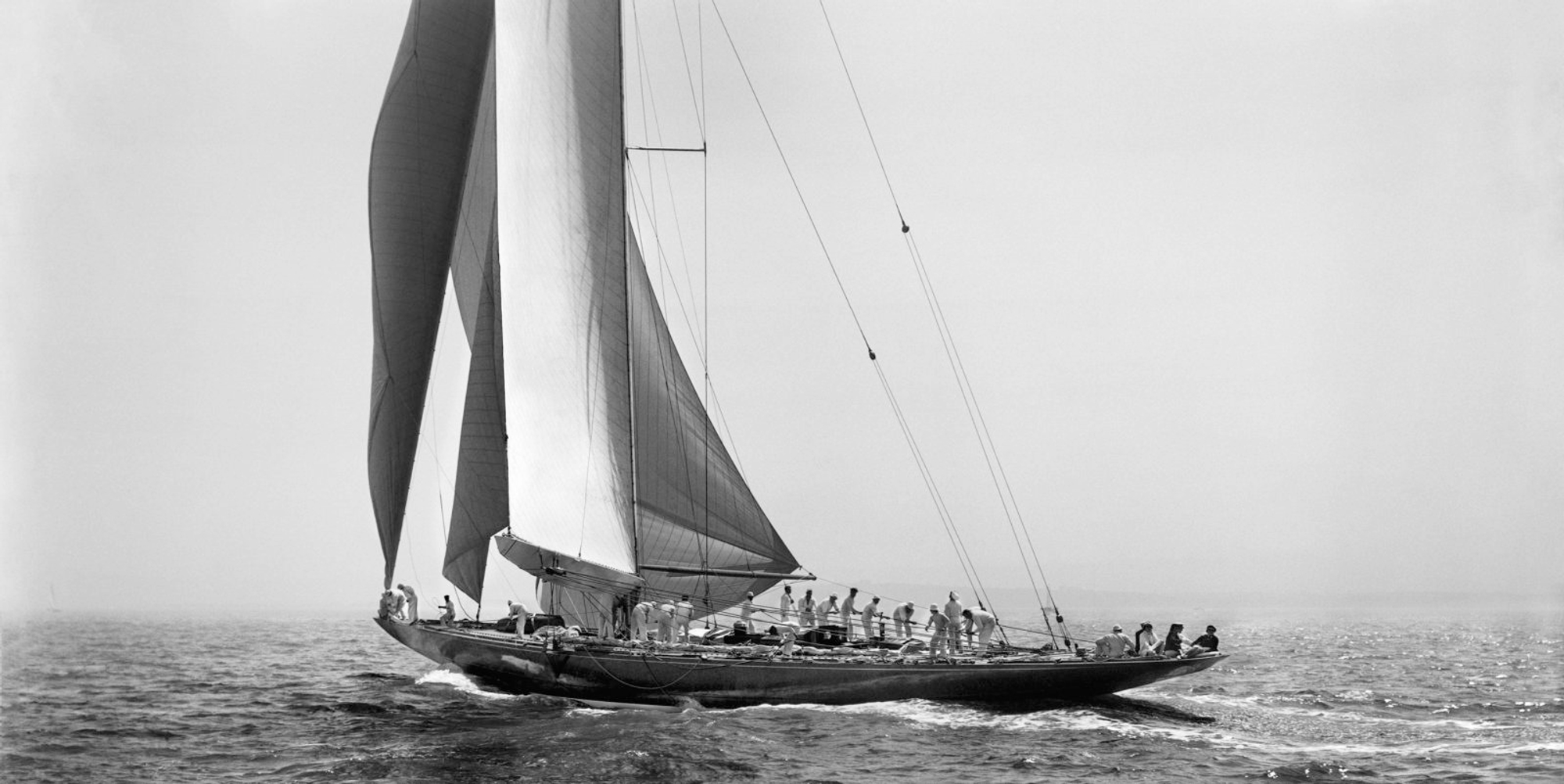 A mile from the outer mark, with the wind shifting forward, Sopwith called for the quadrilateral jib to be broken out and an additional large staysail to be set whilst the genoa was removed and in the ensuing upwind leg, the English matched the Americans tack for tack, all the while pulling ahead. Endeavour was 16 seconds up at the first mark but 1 minute 31 seconds up at the second with just a reach to the finish. However, without the powerful genoa, Endeavour set a ballooner on too shy a course and saw her lead dwindle as the Americans came fast astern. By the finish, Sopwith held on, and the final winning margin was some 51 seconds. 2-0 to the Challenger and it was game on for the America’s Cup. After a cancelled day with no wind, the next race was held on the 20th September 1934 and it was a race where all seemed lost for the Americans until a remarkable piece of navigating turned the tide on the whole Cup contest. On a leeward / windward start, both boats set away under full canvas in a light and shifting north-easterly and quickly the more-canvassed Endeavour ground into a commanding lead. Some careless sail calls and debatable tactics from Vanderbilt saw Rainbow slip further and further behind, eventually reaching the outer mark some 6 minutes and 39 seconds behind with only a long reach on starboard to the finish. Handing the wheel over to Sherman Hoyt, Vanderbilt had all but given up and retired below for coffee and sandwiches, but Newport was about to serve up a classic. Keeping close eyes on the boat ahead, Hoyt noticed the English falling into a hole in the wind and headed high to sail around. The wind was now well forward and both boats were headed close hauled. Sopwith threw in two tacks to try and stay to windward of Rainbow and in doing so, paid away her lead as the American boat straight-lined and the final of those tacks saw Endeavour wallow badly, unable to get up to speed. Rainbow sailed through to leeward and gained the lead whilst the navigators on both boats desperately tried to ascertain the position of the finishing buoy. Zenas Bliss on Rainbow called it to leeward and with that, a returning Vanderbilt gave the order to “carry on” with Endeavour up to windward and far off the lay-line to the mark. At the finish, Bliss had called it correctly and in a most dramatic and unexpected fashion, secured a 3 minute and 26 second victory. 2-1 but the pendulum had swung. 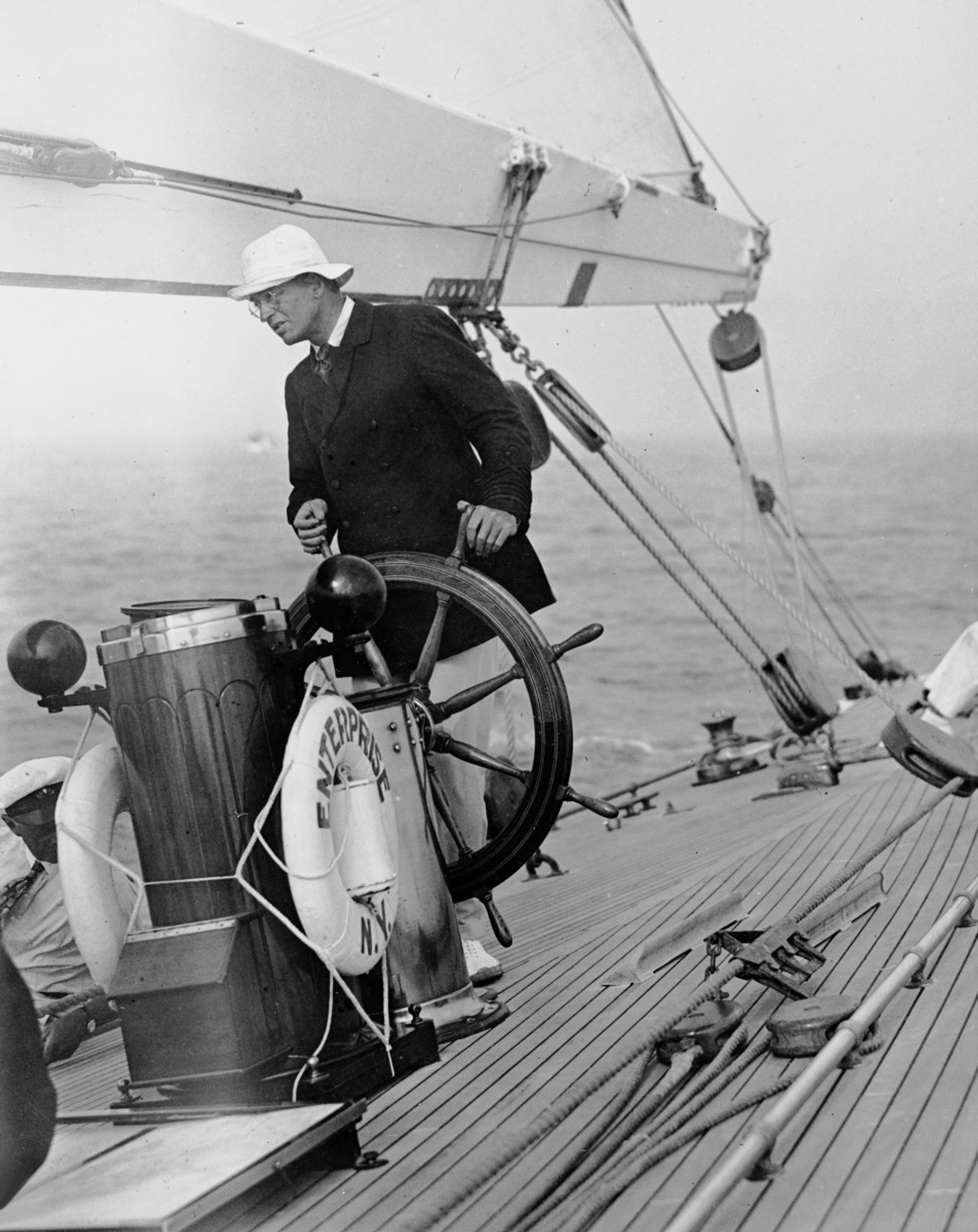 Now came a masterstroke from Vanderbilt, the undisputed genius at building his boats into winners. Recognising that Rainbow was at a considerable disadvantage downwind when dead-running under parachute spinnaker, he remembered that Yankee had enjoyed a similar advantage in the trials and immediately contacted Frank Paine, the designer of the yacht and who had sailed onboard during the trials, to join the Rainbow afterguard. Paine arrived and with him came one of the Yankee spinnakers whilst during the lay-day, Vanderbilt instructed for some 4,000lbs of ballast to be added in a search for better waterline performance. And it was fireworks in the starting box for race four with Vanderbilt now determined to capitalise on his momentum, but it was a race where sharp practices, according to an English standpoint, were to be displayed and led to considerable dismay with the New York Yacht Club’s protest committee. An incident before the start as Endeavour gybed from a starboard reach to head back to the line with Rainbow not keeping clear and forcing the English to take avoiding action was the first debatable point but the protest wasn’t heard due to the absence of a protest flag. The second however, on the first reaching leg where Endeavour came up for a luff, is one that is still debated to this day. Having rounded the top mark ahead, the Challenger was caught short with less sail area up on the reach carrying her quadrilateral sail whilst the Defender had opted to change for a large genoa late on the beat into the top mark. With more horsepower, Rainbow held high and started to close the gap whilst Endeavour had borne away below the rhumb-line in order to change up her sails. Once complete, Endeavour narrowed the gauge and went into a luff to defend her position which the Americans failed to respond to with Vanderbilt believing that the English angle meant she could not touch forward of the rigging. Sopwith bore away to avoid an inevitable collision but again, the protest flag wasn’t flown as the custom under the Yacht Racing Association rules in England was to fly the flag at the end of the race. The NYYC reverted to its own rules on the matter and held firm, insisting that a flag must be flown immediately in order to give the protested yacht the chance to counter-protest should they see fit. Rainbow seized the lead and sailed on to a bitter-sweet 1 minute 15 seconds victory and draw the series level. Stepping ashore, Sopwith, having seen the improved performance of Rainbow on the reaching leg, reversed the decision to strip out the below-deck quarters taken when the two boats were measured and inspected before the series started, and ordered the 3,360lbs of weight to be replaced as ballast – whether Sopwith’s bath came back is not known! Race five was held in 12 knots of building breeze on Monday 24th September 1934 and featured a leeward / windward course. Rainbow was first to set her parachute spinnaker under the control of Frank Paine and quickly established a lead whilst Endeavour struggled with crew work. Vanderbilt was looking imperious and even a slight chafing of the spinnaker that turned into a tear towards the bottom mark and a very near man overboard incident that was thankfully recovered through very quick thinking by the well-drilled crew, they drew out a lead of some 4 minutes 38 seconds before the turn and beat home. Rainbow camped on Endeavour’s wind and the result was never in doubt, recording a win by 4 minutes and 1 second to take the lead in the series. With Sopwith smarting from the perceived injustices he felt from the incidents in race four and Vanderbilt determined to establish his dominance and close out the series, race six began yet again with an incident in the dying seconds of the pre-start. In the final approaches to the line again on a leeward / windward course, Endeavour was heading to the line reaching on port tack whilst Rainbow was borne away running for the portside of Endeavour on starboard gybe. At the last minute, Vanderbilt passed underneath the stern of Endeavour, tacked and broke out his large genoa. Both boats protested but ultimately both were withdrawn, with Sopwith the first to retract, but it was Endeavour that held the lead and crossed the start line with a 46 second advantage. After half an hour, with both boats sailing under genoa, Rainbow drew level and Endeavour luffed her head to wind gaining a significant 100-yard advantage immediately afterwards as the boats came back on course, but the race was ultimately decided on Vanderbilt’s decision to launch a small spinnaker a little while later, whilst Endeavour continued under her genoa. As the first mark approached, and with Rainbow’s forestay hidden from view as the trailing yacht, Vanderbilt called for her quadrilateral jib to be hoisted as he recognised that the wind had built too much for a larger genoa on the returning windward leg. Sopwith’s crew had failed to see the move and rounded 1 minute and 9 seconds up but with too much sail area in the genoa to control. Immediately Vanderbilt initiated a tacking duel that the Challenger was simply no match for and with her quadrilateral working perfectly and under the expert trim of the Rainbow crew and a fortunate 25-degree shift in her favour, by the final top mark, the American’s lead was almost three minutes. But the final race of 1934 was anything but done. Rainbow rounded and were forced to launch a parachute spinnaker borrowed from the Morgan family’s Weetamoe that was full in the foot and refused to set properly. Endeavour meanwhile launched her enormous race spinnaker and closed the gap, bring up fresh breeze coming out of Buzzards Bay. Vanderbilt asked for Sherman Hoyt to replace Jack Parkinson on the wheel for the tense run to the finish and the Hoyt / Bliss magic was once again re-enacted. Hoyt asked Bliss for the bearing to the finish mark but also a point one mile to leeward of the finish, gambling on Sopwith’s tendency to try and keep a cover regardless of course. True to form, Sopwith was forced to sail lower and slower, and almost by the lee, to try and cover Rainbow who were steering a false course knowing that if Endeavour got to her lee quarter, they could harden up and steer directly for the finish line. The tactic worked a treat by two master tacticians and with just a mile left to run, they sheeted on and held course to record a stunning 55 second victory against the odds and retain the America’s Cup for the New York Yacht Club. Sopwith had genuinely come closer than any challenger before but ultimately was outclassed on the water by a team operating at the very maximum of what their boat was capable of. In Harold Vanderbilt, they met a fierce competitor whose working-up of boats was now legendary but in Sherman Hoyt and Zenas Bliss, the Endeavour afterguard simply had no answer to their navigational and tactical genius. Speaking afterwards, Sopwith, still unhappy with how the series had unfolded, commented: “I do not feel vindictive at my treatment at the hands of the New York Yacht Club, but I do feel completely disillusioned. I came over here for the good of the sport but found that the races were run as a big business, something I was not prepared to contend with.” The aftermath of the 1934 regatta was mired in accusation and counter-claims played out in communications between the yacht clubs and in the media by Sopwith, Charles Nicholson and Vanderbilt with questions around sailing rules interpretations high on the agenda. The Americans stuck to their lines, the English contested furiously and the famous headline recorded on both sides of the Atlantic after the infamous race four became part of America’s Cup legend: “Britannia rules the waves but America waives the rules.” Thomas Sopwith would be back – more the wiser for the experience. Ottawa Live CamSitting on the ottawa river.
Advertisement
The Ottawa River has a rich and varied history that spans thousands of years. The river has been a vital lifeline for Indigenous peoples, explorers, and settlers for centuries, providing transportation, food, and a source of livelihood. The Ottawa River was first used by Indigenous peoples for transportation and fishing. The Algonquin and Huron-Wendat were among the first to use the river and its tributaries, and many Indigenous communities continue to rely on the river to this day. In the 17th century, European explorers such as Samuel de Champlain began to use the Ottawa River to travel inland, leading to increased trade and settlement in the region. The fur trade, in particular, became an important industry along the river, with the Hudson's Bay Company and the North West Company establishing trading posts in the area. In the 19th century, the Ottawa River played a key role in the logging industry. Logs were floated down the river to sawmills in Ottawa and other cities, leading to the growth of the timber industry and the development of many communities along the river. During the early 20th century, the Ottawa River became an important source of hydroelectric power. The Chaudière Falls in Ottawa were used to generate electricity, and several dams were built along the river to harness its power. Today, the Ottawa River remains an important part of the region's economy and culture, with many communities relying on it for tourism, fishing, and recreation. It is also a vital source of drinking water for millions of people, making efforts to protect its health and ecosystem of paramount importance. Top Tourist AttractionsThe Ottawa River and its surrounding area offer a range of tourist attractions that cater to a variety of interests. Here are some of the top attractions in the region:
The climate of the Ottawa River region varies throughout the year, with four distinct seasons. Here's a brief overview of the region's climate:
Overall, the Ottawa River region experiences a continental climate, with temperature and precipitation patterns influenced by its location in eastern Canada and its proximity to the Great Lakes. Visitors should be prepared for a range of weather conditions, depending on the season of their visit. The Ottawa River flows through Eastern Ontario and Western Quebec in Canada. It is approximately 1,271 kilometers (790 miles) long and drains an area of approximately 146,300 square kilometers (56,500 square miles). The Ottawa River begins in the province of Quebec, near the town of Lac des Outaouais. It flows westward, forming the boundary between Quebec and Ontario for much of its length, before emptying into the St. Lawrence River near Montreal. The river is fed by numerous tributaries, including the Gatineau River, the Rideau River, and the Madawaska River. It also forms several important lakes, including Lake Timiskaming, Lake Coulonge, and Lake Deschenes. The geography of the Ottawa River region is characterized by rolling hills, forests, and wetlands. The river and its tributaries provide habitat for a wide variety of plant and animal species, including moose, beaver, and various species of fish. The river also forms several notable landmarks and features, including the Rideau Falls, Chaudière Falls, and the rapids of the Deschênes Rapids. The river and its surroundings offer many opportunities for outdoor activities such as boating, fishing, hiking, and camping. Overall, the Ottawa River and its geography play an important role in the region's history, economy, and culture, and continue to be a vital resource for the communities that rely on it.
Can Ben Ainslie and Jim Ratcliffe win the America’s Cup for Britain?
Tarquin Cooper Roula Khalaf, Editor of the FT, selects her favourite stories in this weekly newsletter. “We probably had more gin and tonics than we should have,” says Sir Jim Ratcliffe, chairman and CEO of the chemicals giant Ineos, as he looks back on his first meeting with the five-time Olympic medallist sailor Sir Ben Ainslie. It was in 2018 when a mutual friend, the yacht broker Chris Cecil-Wright, introduced the pair at the private members’ club 5 Hertford Street. “It wasn’t an approach really, just a drink,” says Ratcliffe. “And the conversation naturally drifted onto the America’s Cup.” He would later joke that it was “the most expensive gin and tonic in history”, after he agreed to back Ainslie’s second campaign to win the coveted Cup, for a reported £110mn. Ainslie had been explaining how the team was at the time backed by a consortium. “I might have said as a throwaway line, if we did get involved, we’d have to do the whole thing rather than sit in a committee,” Ratcliffe recalls. “We’re not very good committee people.” Ineos Team UK (now Ineos Britannia ) was launched to campaign for the 36th America’s Cup in Auckland, New Zealand in 2021. Despite a disappointing start, which saw them place last in the preliminary regatta, they came top in the round robins and challenged Luna Rossa in the Prada Cup final for the honour of challenging Emirates New Zealand in the America’s Cup final. They lost, but it was the furthest a British team had come since 1964. For Ratcliffe, 71, the mission is a question of national pride. “It’s the oldest sporting trophy, and a trophy we’ve never won. Sailing is part of the British DNA. We did rule those waves for a few centuries, but we’ve never won the America’s Cup. It would be quite a thing.”  We were three blokes in our 60s who liked sport – why not? Sir Jim Ratcliffe Ainslie is Britain’s most successful Olympic sailor, winning four golds and a silver between Atlanta 1996 and London 2012, but the America’s Cup has been an ambition since he first set eyes on competing yachts while sailing as a seven-year-old in Falmouth harbour: “I was in total awe of the majesty of these boats, and hooked from then on.” He was part of the winning American team, Oracle USA, for the 34th Cup in 2013 but, like Ratcliffe, he is spurred by the national challenge “of having never won it”. Ratcliffe grew up in Failsworth, Lancashire, the son of a joiner who went on to run a factory making laboratory furniture. He studied chemical engineering at Birmingham University, did an MBA at London Business School in 1980, then worked for Esso before going into private equity. He formed Ineos and began to buy up assets from BP and ICI; by 2007 he had petrochemical plants and refineries from Scotland and mainland Europe to Canada. The 2023 Sunday Times Rich List estimated Ratcliffe’s net worth at around £29.7bn, making him the second most wealthy individual in the UK at the time. He is passionate about sport and adventure. He’s an avid runner, once ran and cycled 600km across Namibia, has climbed the Matterhorn and trekked to the Poles. He says Ineos’s move into sports was a logical progression of that interest – today the company’s portfolio includes Formula One , cycling, Eliud Kipchoge’s sub-2:00 marathon record and now Manchester United. The Qatari businessman Sheikh Jassim bin Hamad Al Thani had initially hoped to acquire the football club outright, but withdrew from bidding in October, leaving Ratcliffe to buy a 27.7 per cent minority shareholding for a reported £1.25bn. He is set to invest a further $100mn by the end of the year, but would not be drawn on details of the negotiations or future plans for the club. “There were three of us running Ineos, all in our 60s,” says Ratcliffe, “We’d all been very successful, we’d all worked for a long time, we’re all from the north of England. We all generally liked sport, so why not? It was a bit of fun and a challenge. I think most normal blokes like sport. I know some people go off in different directions, they might like opera or classical music, but the majority enjoy sport.” Ratcliffe and Ainslie meet every four to six weeks in one of the Ineos offices, depending on where Ratcliffe is. Today it is the Monaco office, which occupies a couple of floors of a building less than 200m from the Casino de Monte Carlo. Inside it’s all motor racing and Hollywood glamour; a photo of Steve McQueen looms large by the coffee bar; vintage steering wheels and retro prints of Monaco and Le Mans line the walls; miniature Grenadiers (the name of the pub in London where Ratcliffe came up with his idea of making his own version of a Land Rover Defender ) sit on a wooden bookshelf: the windows offer wide views over the harbour. But the largest presence is Ratcliffe himself, whose lean 6ft 4in frame stands over everyone else, Ainslie included.  The secret to their working relationship is that Ratcliffe treats Ainslie like any other of his business interests. “We have board meetings for all our businesses, so we don’t treat sailing any differently to one of the chemical businesses or other sports teams,” says Ratcliffe. Ainslie admits he can’t afford to arrive unprepared. “You can’t turn up here and not know if there’s an issue, have analysed it and understood it because Jim has this knack of understanding what the core of an issue is and trying to get to the bottom of it.” “Everything is a learning,” continues Ratcliffe of the decision-making process. “You just sort of home in on it and try to figure out why it’s gone wrong and what we can do to get it back on track. It’s very much consensus driven. There’s no point being hysterical and screaming death. That doesn’t really help. We’ve always said, if there’s any bad news we need to know today. Good news can wait.” It’s an insane piece of technology – a wonder of science Sir Jim Ratcliffe Ratcliffe likens it to F1, where the teams are all engaged in a high-stakes R&D battle to produce a winning car each season. “We’re in a much better place than we were in the previous America’s Cup but, as ever with these things, you don’t know until you actually see all the boats on the water.” Uniquely, Ainslie and the crew can tap into the expertise of the Ineos Mercedes-AMG Petronas F1 team – Ineos is a one-third equal shareholder. “We are the first team that have really engaged heavily with the F1 industry,” says Ratcliffe. It’s a mine of expertise they can call upon. While the Ineos America’s Cup team is about 200, the Mercedes F1 team, based in Brackley, is 1,000 strong. “There’s a whole host of experts across the group that we can tap into. It’s a huge partnership,” says Ainslie. “There are lots of similarities between F1 and the America’s Cup,” adds Ratcliffe. “They’re carbon-fibre structures, they’ve both got foils or wings. The calculations are just the same – one’s working in water, one’s working in air, but it’s just a fluid with a different density.” Besides the designers there’s also the performance expertise of the cycling team Ineos Grenadiers they can dial into. “There’s a lot of expertise that we can understand how to get better performance from our athletes, from sports psychology to physio, you name it,” adds Ainslie. The collaboration has seen the cyclors join the likes of Geraint Thomas and the rest of the Ineos Grenadiers cycling squad on training camps in Mallorca. Although they’re more likely to come from rowing than cycling – Matt Gotrel won a rowing gold in Rio – they were just about able to keep up. “A half-decent cyclist will get up the Sa Calobra climb in 45 minutes but these cyclors are getting there in 30,” says Ratcliffe.  The official boat design, meanwhile, the AC75 , bears as much resemblance to a traditional “displacement” yacht as Top Gun: Maverick ’s Mach-10 Darkstar does to the Wright brothers’ biplane. “It’s an insane piece of technology, a wonder of modern science,” enthuses Ratcliffe. In 2013 hydrofoils were first introduced into America’s Cup yacht design. Acting like an underwater wing, they lift the boat out of the water, freeing it from all resistance. “It’s more like being a pilot these days,” says Ainslie. “There’s a huge amount of energy in these boats,” adds Ratcliffe. “It’s 10 storeys high, 25m long, it travels up to 100kmph and sails on a foil the size of a coffee table. It’s a disaster if you crash them.” Then, in a friendly warning shot across the bow of his skipper, he reminds Ainslie he only has one of them to play with. Serious crashes are rare, but in 2013 British sailor Andrew “Bart” Simpson died when the catamaran Artemis capsized, prompting a slew of safety reviews. “We take safety very seriously,” adds Ainslie. Each crew member wears a helmet, carries oxygen and a knife and there are spare air canisters in the cockpit. The main challenge is getting to the starting line at all. And even then the America’s Cup is brutally unforgiving. First, Ineos Britannia must win the challengers’ regatta just to earn the right to take on the Cup holder, Emirates Team New Zealand . Only then will the real battle begin. The preliminary round takes place in Barcelona in late August, with the final, the Louis Vuitton America’s Cup Match , taking place from 12 to 27 October. “The next six months are obviously crucial. It’s hard work but it’s what you live for,” says Ainslie. For Ratcliffe, all eyes are on the prize – and there’s only one in this game. “Queen Victoria asked who came second in 1851 and was told, ‘There’s no second, Ma’am, you know,’” he says. “We wouldn’t be here if we didn’t think winning was possible. There’s no point – no interest – in coming second.” Promoted ContentExplore the series.  Follow the topics in this article
 | |||||
IMAGES
VIDEO
COMMENTS
The Britannia Yacht Club (BYC) is a private social club, yacht club, and tennis club based in Britannia, a neighborhood in Ottawa, Ontario, Canada.It was founded in 1887 by a group of cottagers. [citation needed]The BYC is located on an extension of land at the eastern end of Lac Deschênes, near the Deschênes Rapids on the Ottawa River.A land block owned by the National Capital Commission on ...
Britannia Yacht Club's roots come from an association of cottagers who spent their summers at Britannia-on-the-Bay. Formed in 1887, they were known as the Britannia Aquatic Club and met for the first nine years in an old saw mill on the water, between Rowatt and Jamieson Street. The name was changed to the Britannia Nautical Club and then to ...
Many played a leading role in the early history of what's now the Britannia Yacht Club, whose 19th-century clubhouse was the eighth property on the designation list.
The Britannia Yacht Club is located in the west end of Ottawa, at the head of the Deschênes Rapids, providing access to 45 kilometres of picturesque sailing waters on the Ottawa River. Incorporated in 1887, BYC is one of the oldest yacht clubs in Canada. The well-protected harbour accommodates 250 keelboats. Dry sail facilities are provided ...
Britannia Yacht Club's History. Britannia Boat House/Boating Club A Sailing and Social History 1895 to 1918. Britannia Boating Club in World War I Our History - 1914 to 1918 ...
I n 1887, the Britannia Aquatic Club was established as an informal organization by summer residents interested in boating and other water activities. One of Ottawa's many sawmills, built by J.C. Jamieson where Lac Duchenes meets the Ottawa River, became the meeting place. This was the start of the club which in now known as the Britannia Yacht Club.
The Britannia Yacht Club (BYC) is a private social club, yacht club and tennis club based in Britannia, Ottawa, Ontario. It was founded in 1887 by a group of cottagers. The members have contributed to the sports of yachting and tennis. The BYC is celebrating its 125th anniversary in 2012. Contents.
A Floating Palace. Britannia was launched from the John Brown & Company shipyard in Clydebank, Scotland, on 16 April, 1953. For over 44 years the Royal Yacht served the Royal Family, travelling more than a million nautical miles to become one of the most famous ships in the world. To Queen Elizabeth II, Britannia provided the perfect Royal ...
Discover Sailing! Learn-to-sail at Britannia Yacht Club this year and find out why so many have embraced the sailing lifestyle. Advantage Boating, one of the oldest (established in 1992) and largest sailing schools in Canada catering to adults, has a large team of experienced and enthusiastic instructors wanting to help "wannabe" sailors become sailors for life and more experienced sailors ...
The Britannia Yacht Club is located in the west end of Ottawa, at the head of the Deschênes Rapids, providing access to 45 kilometres of picturesque sailing waters on the Ottawa River. Incorporated in 1887, BYC is one of the oldest yacht clubs in Canada. The well-protected harbour accommodates 250 keelboats.
Her Majesty's Yacht Britannia is the former royal yacht of the British monarchy.She was in their service from 1954 until 1997. She was the 83rd such vessel since King Charles II acceded to the throne in 1660, and is the second royal yacht to bear the name, the first being the racing cutter built for the Prince of Wales in 1893. During her 43-year career, the yacht travelled more than a million ...
Britannia Yacht Club Ottawa, Nepean, Ontario K2B 8J8, Canada . Created By: Douglas T Stiff. Information. This clubhouse was built in 1896, on property leased from Ottawa lumber baron J. R. Booth, after the Britannia Aquatic Club had outgrown John Jamieson's converted sawmills and cottages that had been used since its foundation in 1887. The ...
Former members of the Britannia Yacht Club (BYC) are being asked to get in touch as the club approaches its 60th anniversary. The club, which was originally founded in 1959, has been re-launched at Britannia Royal Naval College (BRNC) with Captain Jol Woodard, the current Commanding Officer of BRNC, taking on the role of Commodore of the club.
The royal family has a long history of seafaring—the first official royal yacht was the HMY Mary (HMY stands for His or Her Majesty's Yacht), gifted to Charles II by the Dutch in 1660. In fact ...
English: The Britannia Yacht Club (BYC) is a private social club, yacht club and tennis club based in Britannia Ottawa.It was founded in 1887 by a group of cottagers. The members have contributed to the sports of yachting and tennis.The organization is celebrating its 125th anniversary in 2012.
The Britannia Yacht Club (BYC) is a private social club, yacht club and tennis club based in Britannia Ottawa, Ontario. It was founded in 1887 by a group of cottagers. [citation needed] The members have contributed to the sports of yachting and tennis. The non profit corporation celebrated its 125th anniversary in 2012.
Britannia Yacht Club offers a wide range of programs in Ottawa that. cater to a full range of sailing interests, abilities and age groups. Most boat owners prefer pleasure sailing and cruising along the 45 km. of the Ottawa River that is directly accessible from our Club. For those who like a challenge and the camaraderie of racing keel boats,
STV Black Jack is a brigantine operated by the Ottawa-based youth charity Bytown Brigantine, Inc. Black Jack sails on the Ottawa River between Brittania Yacht Club and Quyon, Quebec.On May 2, 2004, Black Jack was designated "Ottawa's Signature Tall Ship". Black Jack was the first ship in service with Bytown Brigantine, Inc., a charitable organization devoted to providing sail training ...
HISTORY / 1934 BRITANNIA RULES THE WAVES AND AMERICA WAIVES THE RULES. ... and the New York Yacht Club appointed Vanderbilt's team to the task of defending the America's Cup. Over in England, Endeavour was putting all-comers to the sword in a series of races in Harwich and a further final trial series in and around the Solent and out ...
The Britannia Yacht Club History . For over 130 years, Britannia Yacht Club has provided a quick and easy escape from urban Ottawa into lakeside cottage country that unbelievably is just fifteen minutes from downtown. Britannia Yacht Club's historical Clubhouse has spectacular views of the Ottawa River and is the focal point of the Club's ...
The Bring-on-the-Bay 3km and 1.5km open-water swim from the Nepean Sailing Club to the Britannia Yacht Club hosts some 800 swimmers annually. The annual IronMan Canada event will be held in Ottawa on August 3, 2025, with the 4.2km swim loop running parallel to the village in Lac Deschênes. Notables in the community
Britannia Yacht Club; 2777 Cassels Street - Ottawa; Ontario K2B 6N6 - Canada; 613-828-5167 [email protected] https://byc.ca/ History. The Ottawa River has a rich and varied history that spans thousands of years. The river has been a vital lifeline for Indigenous peoples, explorers, and settlers for centuries, providing transportation, food, and ...
It was in 2018 when a mutual friend, the yacht broker Chris Cecil-Wright, introduced the pair at the private members' club 5 Hertford Street. "It wasn't an approach really, just a drink ...